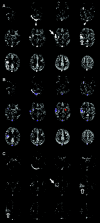Arteriovenous shunt visualization in arteriovenous malformations with arterial spin-labeling MR imaging
- PMID: 18397967
- PMCID: PMC7978181
- DOI: 10.3174/ajnr.A0901
Arteriovenous shunt visualization in arteriovenous malformations with arterial spin-labeling MR imaging
Abstract
Background and purpose: A reliable quantitative technique for measuring arteriovenous (AV) shunt in vascular malformations is not currently available. Here, we evaluated the hypothesis that continuous arterial spin-labeled (CASL) perfusion MR imaging can be used to detect and measure AV shunt in patients with arteriovenous malformations (AVMs).
Materials and methods: CASL perfusion MR imaging was performed in 7 patients with AVMs. Semiquantitative AV shunt estimates were generated based on a thresholding strategy by using signal-intensity difference (DeltaM) images to avoid potential errors in cerebral blood flow (CBF) calculation related to abnormal transit times and nonphysiologic blood-tissue water exchange in and around the AVMs. The potential for measuring CBF in regions distant from and near the AVM was explored, as was the relationship of CBF changes related to the size of the shunt.
Results: In all 7 cases, striking increased intensity was seen on CASL perfusion DeltaM maps in the nidus and venous structures draining the AVM. Shunt estimates ranged from 30% to 0.6%. Mean CBF measurements in structures near the AVMs were not significantly different from the contralateral measurements. However, CBF in adjacent ipsilateral white matter increased relative to the contralateral side as the percent shunt increased (P = .02). Cortical gray matter CBF Delta (contralateral-ipsilateral) values demonstrated the same effect, but the correlation was weak and not significant. Thalamic CBF decreased ipsilaterally with increasing percent AV shunt (P = .01), indicating a possible steal effect. Basal ganglia Delta values showed little change in CBF with the size of the AV shunt.
Conclusion: CASL perfusion MR imaging can demonstrate AV shunting, providing high lesion conspicuity and a novel means for evaluating AVM physiology.
Figures





Similar articles
-
Arterial spin labeling magnetic resonance imaging: toward noninvasive diagnosis and follow-up of pediatric brain arteriovenous malformations.J Neurosurg Pediatr. 2015 Apr;15(4):451-8. doi: 10.3171/2014.9.PEDS14194. Epub 2015 Jan 30. J Neurosurg Pediatr. 2015. PMID: 25634818
-
Evaluation of the degree of arteriovenous shunting in intracranial arteriovenous malformations using pseudo-continuous arterial spin labeling magnetic resonance imaging.Neuroradiology. 2015 Aug;57(8):775-82. doi: 10.1007/s00234-015-1533-5. Epub 2015 Apr 24. Neuroradiology. 2015. PMID: 25903432
-
Evaluating post-treatment residual intracranial arteriovenous shunting: a comparison of arterial spin labeling MRI and digital subtraction angiography.Neuroradiology. 2025 May;67(5):1233-1250. doi: 10.1007/s00234-025-03548-7. Epub 2025 Feb 6. Neuroradiology. 2025. PMID: 39912896 Free PMC article.
-
Management of patients with brain arteriovenous malformations.Eur J Radiol. 2003 Jun;46(3):195-205. doi: 10.1016/s0720-048x(03)00091-3. Eur J Radiol. 2003. PMID: 12758114 Review.
-
Role Of Radiosurgery In Arteriovenous Malformations.J Ayub Med Coll Abbottabad. 2018 Jul-Sep;30(3):449-457. J Ayub Med Coll Abbottabad. 2018. PMID: 30465384 Review.
Cited by
-
Three-dimensional gradient and spin-echo readout for time-encoded pseudo-continuous arterial spin labeling: Influence of segmentation factor and flow compensation.Magn Reson Med. 2021 Sep;86(3):1454-1462. doi: 10.1002/mrm.28807. Epub 2021 May 4. Magn Reson Med. 2021. PMID: 33942371 Free PMC article.
-
Follow-Up MRI for Small Brain AVMs Treated by Radiosurgery: Is Gadolinium Really Necessary?AJNR Am J Neuroradiol. 2020 Mar;41(3):437-445. doi: 10.3174/ajnr.A6404. Epub 2020 Feb 6. AJNR Am J Neuroradiol. 2020. PMID: 32029465 Free PMC article.
-
Controlling T2 blurring in 3D RARE arterial spin labeling acquisition through optimal combination of variable flip angles and k-space filtering.Magn Reson Med. 2018 Oct;80(4):1391-1401. doi: 10.1002/mrm.27118. Epub 2018 Feb 9. Magn Reson Med. 2018. PMID: 29427325 Free PMC article.
-
Arterial spin labelling could detect the occlusion of inferior petrosal sinus for cavernous sinus dural arteriovenous fistula.BJR Case Rep. 2024 Oct 25;10(6):uaae039. doi: 10.1093/bjrcr/uaae039. eCollection 2024 Nov. BJR Case Rep. 2024. PMID: 39529909 Free PMC article.
-
Clinical applications of arterial spin labeling of the intracranial compartment in vascular anomalies-A case-based review.Neuroradiol J. 2023 Dec;36(6):638-650. doi: 10.1177/19714009221130490. Epub 2022 Sep 29. Neuroradiol J. 2023. PMID: 36172883 Free PMC article.
References
-
- Greenberg MS. Handbook of Neurosurgery, 4th ed. Lakeland, FL: Greenberg Graphics;1997. :871
-
- Ondra SL, Troupp H, George ED, et al. The natural history of symptomatic arteriovenous malformations of the brain: a 24-year follow-up assessment. J Neurosurg 1990;73:387–91 - PubMed
-
- Carroll TJ, Grist TM. Technical developments in MR angiography. Radiol Clin North Am 2002;40:921–51 - PubMed
-
- Langer DJ, Song JK, Niimi Y, et al. Transarterial embolization of vein of Galen malformations: the use of magnetic resonance imaging noninvasive optimal vessel analysis to quantify shunt reduction—report of two cases. J Neurosurg 2006;104:41–45 - PubMed
Publication types
MeSH terms
Substances
Grants and funding
LinkOut - more resources
Full Text Sources
